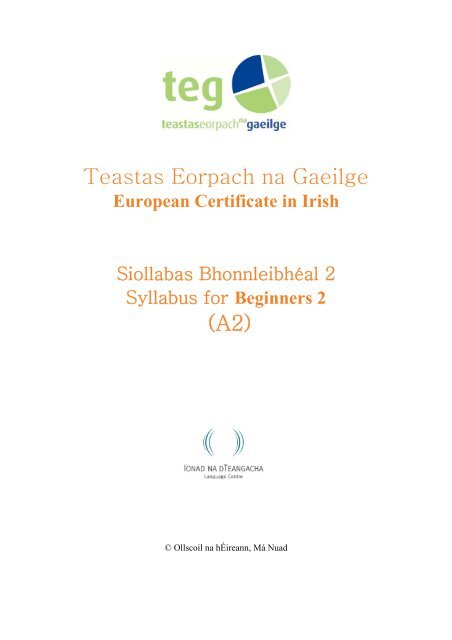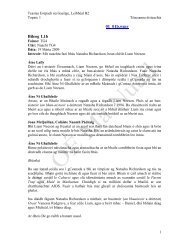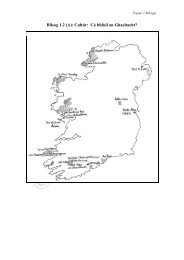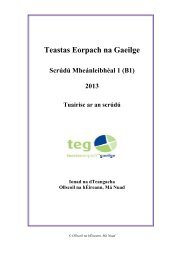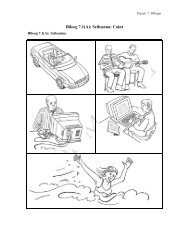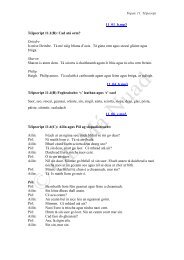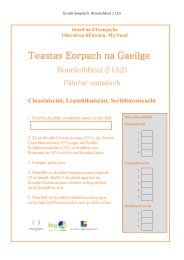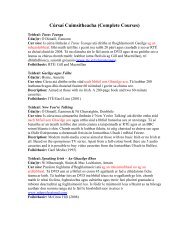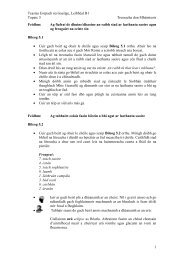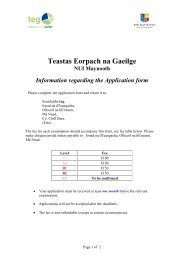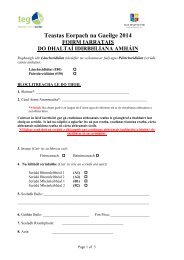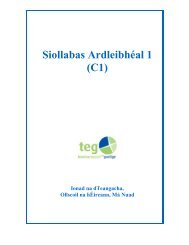Create successful ePaper yourself
Turn your PDF publications into a flip-book with our unique Google optimized e-Paper software.
Teastas Eorpach na Gaeilge<br />
European Certificate in Irish<br />
Siollabas Bhonnleibhéal 2<br />
Syllabus for Beginners 2<br />
(A2)<br />
© Ollscoil na hÉireann, Má Nuad
Syllabus A2<br />
Contents Page<br />
1. Introduction.............................................................................................3<br />
2. The content of syllabus A2 (Bonnleibhéal 2 /Beginners 2) ..................3<br />
3. Grammar .................................................................................................4<br />
4. The learners and the language learning process .....................................4<br />
4.1 Learning and communication stra<strong>teg</strong>ies..............................................................5<br />
4.2 Language awareness............................................................................................7<br />
5. Irish culture .............................................................................................9<br />
6. Skills .......................................................................................................9<br />
6.1 Speaking and Listening Comprehension..............................................................9<br />
6.2 Reading Comprehension......................................................................................9<br />
6.3 Writing ...............................................................................................................10<br />
7. Bonnleibhéal 2/Beginners 2 (A2) examination ....................................10<br />
8. <strong>Topic</strong>s and Functions ......................................................................11<br />
<strong>Topic</strong> 1: Social occasions....................................................................11<br />
<strong>Topic</strong> 2: The family..............................................................................13<br />
<strong>Topic</strong> 3: Pastimes..................................................................................16<br />
<strong>Topic</strong> 4: Daily travel ............................................................................19<br />
<strong>Topic</strong> 5: Work........................................................................................22<br />
<strong>Topic</strong> 6: Talking about the weekend ................................................25<br />
<strong>Topic</strong> 7: Food and drink......................................................................27<br />
<strong>Topic</strong> 8: Health and illness .................................................................31<br />
<strong>Topic</strong> 9: Describing people ................................................................33<br />
<strong>Topic</strong> 10: Clothes and shopping........................................................36<br />
<strong>Topic</strong> 11: Planning holidays...............................................................38<br />
<strong>Topic</strong> 12: Directions, location and movement ...............................41<br />
<strong>Topic</strong> 13: Favours and permission....................................................43<br />
<strong>Topic</strong> 14: Making arrangements........................................................45<br />
© National University of Ireland, Maynooth 2
1. Introduction<br />
• This syllabus outlines the range of language in which learners should be<br />
competent before they undertake the A2 (Bonnleibhéal 2/Beginners 2)<br />
examination.<br />
Syllabus A2<br />
• The table below illustrates how the Irish language syllabi and examinations align<br />
with the Common European Framework of Reference for Languages: Learning,<br />
Teaching and Assessment (Council of Europe, 2001).<br />
Framework<br />
reference<br />
A1<br />
A2<br />
B1<br />
B2<br />
C1<br />
C2<br />
Study/learning<br />
hours<br />
80-100<br />
160-200<br />
350-400<br />
500-600<br />
1000<br />
1500<br />
Irish Syllabus<br />
Syllabus A1<br />
Syllabus A2<br />
Syllabus B1<br />
Syllabus B2<br />
Siollabas C1<br />
Available 2010<br />
2. The content of syllabus A2 (Bonnleibhéal 2 /Beginners 2)<br />
Irish Examination<br />
Bonnleibhéal 1/<br />
Absolute Beginners<br />
Bonnleibhéal 2/<br />
Beginners 2<br />
Meánleibhéal 1/<br />
Lower Intermediate<br />
Meánleibhéal 2/<br />
Upper Intermediate<br />
Ardleibhéal 1/Advanced 1<br />
Available 2010<br />
• The syllabus outlines the minimum language level required to enable a learner to<br />
function within a defined subject range. (See list of <strong>Topic</strong>s). It is important to<br />
remember, however, that the needs of the learners must always be taken into<br />
account in the designing of teaching materials.<br />
• This is a communicative syllabus. This means that it focuses on various<br />
functions pertaining to particular topics and subject-matter. Examples are given<br />
of expressions which could be used to introduce the learners to those functions.<br />
As well as that, lists of useful vocabulary and phrases are provided for teaching<br />
this subject-matter to the class. The lists of vocabulary and expressions in this<br />
syllabus are not exhaustive and teachers are advised to take the needs of the<br />
learners into account in preparing their own courses.<br />
• It is of vital importance that the learners’ needs are to the forefront in the<br />
creation of a course of instruction or teaching programme. These needs must be<br />
fully ascertained through the use of questionnaires and interviews, prior to the<br />
© National University of Ireland, Maynooth 3
Syllabus A2<br />
preparation of class lessons. For example, what are the learners’ pastimes, what<br />
type of work do they do, where do they live, what are their skills, what subjectmatter<br />
would they like to cover in the class and so on. With such information to<br />
hand, class lessons can take into account the needs and interests of the learners.<br />
• Teachers can adapt the content of the syllabus as best suits the course of<br />
instruction they put together. That is to say, it is not necessary to stick to the<br />
order or layout of the units as given in the syllabus. However, it is important to<br />
cover the various functions and the examples of phrases/vocabulary.<br />
• In this syllabus, it is presumed that teachers will adapt the phrases to the norms<br />
of their own dialect. For example, in the Ulster dialect for the sentence ‘I’m<br />
sorry I’m late’ one would normally say ‘Tá mé buartha go bhfuil mé mall’ but<br />
‘Tá brón orm go bhfuil mé déanach’ is what is said in other dialects. It is<br />
expected at this level that learners will be comfortable in using whatever version<br />
prevails in their own dialect and that they would understand whatever are the<br />
principal versions used in the other dialects. Likewise, in relation to other<br />
aspects of vocabulary (for example ‘druid’/‘dún’) and of grammar (for example,<br />
‘ar an bhóthar’/’ar an mbóthar’), it suffices at this level that learners can use<br />
one version correctly and understand the other versions.<br />
3. Grammar<br />
• One of the distinctive features of a communicative syllabus is the way in which<br />
grammar is presented. In traditional syllabi, grammar was given pride of place.<br />
In a communicative syllabus, however, points of grammar are taught within the<br />
context of the subject-matter and the topics. For example, in <strong>Topic</strong> 11 (Planning<br />
Holidays), periods of time are referred to: ‘Bhí mé sa Spáinn ar feadh coicíse’/’I<br />
was on holidays in Spain for a fortnight’. The examples of ‘ar feadh<br />
seachtaine‘/for a week’, ‘ar feadh coicíse’/’for a fortnight’ and ‘ar feadh<br />
míosa’/‘for a month’ are given and it is explained that ‘ar feadh’ is followed by<br />
the genitive case and that is the reason why ‘seachtain’ changes to ‘seachtaine’.<br />
We do not advise that the learners are introduced to every other rule relating to<br />
the genitive case at this point. It is sufficient at this level that learners<br />
understand what it is and why a change occurs after ‘ar feadh’. Certainly,<br />
central points of grammar should not be overlooked and it is often useful to<br />
focus on a particular point of grammar in a formal way.<br />
4. The learners and the language learning process<br />
• Much of what is mentioned below is mentioned in Syllabus A1 and it is<br />
mentioned here to remind teachers that knowledge of language stra<strong>teg</strong>ies and<br />
language awareness is central to any course of instruction.<br />
© National University of Ireland, Maynooth 4
Syllabus A2<br />
• Teachers are well aware that learners do not necessarily progress at the same<br />
rate. Many factors influence the success of learning, for example, the learner’s<br />
background, personality, age, motivation etc.<br />
• Much is now understood about the importance of the way in which the learner<br />
engages in the learning process. The more they reflect on themselves as<br />
learners, on their weaknesses and talents, and on the stra<strong>teg</strong>ies they use, the<br />
more successful they will be in learning a language.<br />
• It cannot be presumed that all learners engage in reflection on their learning<br />
nor that they understand the importance of such an approach. Therefore, the<br />
teacher is obliged to urge and direct the learners to get to know their own<br />
learning style and to increase their awareness of the stra<strong>teg</strong>ies that help them<br />
to progress.<br />
• Below are some of the stra<strong>teg</strong>ies which should be emphasised in the teaching<br />
and learning process to assist learners to benefit fully from their study.<br />
4.1 Learning and communication stra<strong>teg</strong>ies<br />
• Making mistakes is a natural part of learning a language and learners will<br />
almost certainly experience difficulty in their efforts to use the language.<br />
Communicative stra<strong>teg</strong>ies help the learners to be more effective in speaking<br />
because they plan what it is they want to say, while monitoring how they are<br />
succeeding and taking steps to correct problems as they arise. Compensatory<br />
stra<strong>teg</strong>ies help the learners to survive when gaps in their knowledge threaten<br />
communication.<br />
• Learners will benefit from repeated opportunities to develop the use of such<br />
stra<strong>teg</strong>ies during the learning process and to adopt a more active approach<br />
with regard to their own learning. Teachers should make a consistent effort to<br />
inform learners of how to use the appropriate stra<strong>teg</strong>y. A once-off discussion<br />
of learning stra<strong>teg</strong>ies is not sufficient. The use of these stra<strong>teg</strong>ies must be a<br />
central and continuous part of tuition and one of the principles on which the<br />
entire instructional approach is founded. It is not intended that specific<br />
stra<strong>teg</strong>ies and techniques are taught to the learner. What is important is that<br />
they are helped to recognise the effective stra<strong>teg</strong>ies which they already use and<br />
further stra<strong>teg</strong>ies which they could gradually develop.<br />
• Below are some of the stra<strong>teg</strong>ies that learners should use to their benefit:<br />
© National University of Ireland, Maynooth 5
When speaking:<br />
Syllabus A2<br />
• Planning ahead: for example, that the learner would have a store of basic<br />
phrases. (S)he will usually be able to recall a suitable phrase and use it as<br />
required.<br />
• Compensating in the event of the learner lacking specific vocabulary.<br />
Seeking help with regard to a specific word/phrase/point:<br />
Cén Ghaeilge atá air…? (What is the Irish for…?)<br />
Conas a deirtear…? (How does one say…?)<br />
• Questioning others to see if they have understood what has been said.<br />
An dtuigeann tú sin? (Do you understand that?)<br />
• Monitoring progress<br />
- Questioning another/others to determine if what the learner has said<br />
is correct<br />
An bhfuil sin ceart? (Is that correct?)<br />
- Noticing when they have made mistakes and engaging in self-correction.<br />
- Noticing persistent problems which they may have and attempting<br />
to correct them.<br />
When listening:<br />
• Expressing the fact that the learner does not understand something:<br />
Tá brón orm. Ní thuigim sin. (I’m sorry. I don’t understand<br />
that.)<br />
Gabh mo leithscéal, ach ní thuigim sin. (Excuse me, but I don’t<br />
understand that.)<br />
• Seeking clarification:<br />
Cad é a chiallaíonn…? (What is the meaning of…?)<br />
An bhféadfá é sin a mhíniú dom, le do thoil? (Could you explain that<br />
to me, please?)<br />
• Requesting that the interlocutor repeats what he/she has said:<br />
Arís, le do thoil. (Could you repeat, please?)<br />
• Seeking confirmation that the learner has understood what has been said:<br />
An é an Fhraincis a dúirt tú? (Did you say French?)<br />
• Asking the interlocutor to speak more slowly:<br />
An bhféadfá labhairt níos moille, le do thoil? (Could you speak more<br />
slowly, please?)<br />
• Using the context to guess the meaning of words or phrases which the learner<br />
doesn’t understand.<br />
© National University of Ireland, Maynooth 6
While learning in general:<br />
Syllabus A2<br />
The learner should<br />
• understand his/her own individual learning style. What helps and what<br />
obstructs learning? What stra<strong>teg</strong>ies does the learner use to enhance his/her<br />
own learning?<br />
• organise his/her study. Identify areas of weakness and strength and focus on<br />
these, thus making study more effective.<br />
• plan before undertaking tasks.<br />
• monitor progress during specific task work and learning generally.<br />
While working on a text or doing task work:<br />
The learner should<br />
• repeat words or structures aloud or to himself/herself.<br />
• use dictionaries, grammar books, lists of terms, and other resources<br />
correctly.<br />
• ca<strong>teg</strong>orise and order new information as it being learned.<br />
• note/summarise main points.<br />
• use the knowledge which (s)he has already in order to guess the meaning<br />
of new material.<br />
• seek help. For example, ask the teacher or other people to repeat/<br />
clarify/advise/give extra examples.<br />
• work in tandem with other learners.<br />
4.2 Language awareness<br />
• Language awareness refers to the learner’s understanding of the language<br />
learning process and his/her analysis of the way the language works.<br />
• The learner certainly benefits from such an approach as he/she sets out on the<br />
process of acquiring the language.<br />
• The learner should be guided and motivated to investigate the following<br />
phenomena:<br />
- the way in which the language works<br />
- the different patterns that are to be found in the language<br />
- the similarities and differences between Irish and English<br />
- the similarities and differences that exist between Irish and the<br />
learner’s other languages<br />
© National University of Ireland, Maynooth 7
Syllabus A2<br />
• There should be a continuous focus on various aspects of language awareness<br />
during the teaching process. Suitable texts, including written, aural, and visual<br />
texts, can be used to motivate the learner to reflect on these matters. The<br />
purpose of this approach is to assist the language acquisition process by giving<br />
the learner opportunities to identify areas of weakness in his/her information<br />
base, particularly when speaking.<br />
Outlined below are some examples of areas upon which the learner should focus:<br />
• Grammatical terminology<br />
It is important that the learner should be aware of grammatical terminology in<br />
Irish in order that he/she have the necessary skills to analyse the language<br />
grammatically and to make the best use of dictionaries and other reference<br />
materials correctly.<br />
• Syntax<br />
The learner should be able to differentiate between syntax in Irish and in<br />
English. Observe the examples below:<br />
She comes from Cork. Is as Corcaigh í.<br />
Do you like music? Yes. An maith leat ceol? Is maith.<br />
• Emphasis/stress<br />
The learner should recognise how emphasis in a sentence is different in Irish<br />
compared to English. For example:<br />
Bríd: Is maith liom ceol. An maith leatsa ceol?<br />
It is a common mistake in Irish to vocally stress the word ‘leat’, as in the case of<br />
English where the word you (emphatic) is stressed. In Irish, however, the suffix<br />
‘sa’ is added to the prepositional pronoun ‘leat’ for the purpose of emphasis.<br />
• Awareness of pattern<br />
The learner should seek to identify patterns in Irish grammar. By using suitable<br />
texts, one could ask the learner to be attentive to the different grammatical<br />
patterns that may be evident - for example, what happens after the interrogative<br />
forms in the present and past tenses, what changes occur when an adjective is<br />
put with a noun and so forth.<br />
• Register<br />
It is important that the learner be able to identify different contexts that require<br />
a specific register. For example, are there differences in the kind of Irish used<br />
in formal contexts and in informal contexts? Does one greet a person in Irish in<br />
the same way in which one greets someone in other languages?<br />
• Dialects<br />
The learner can be helped to understand the variations that exist between the<br />
dialects. This can be achieved by highlighting the range of expression that<br />
endures in the different dialects. For example, to recognize the main<br />
differences in phrases between the dialects, for example, ‘ní mór dom’ and<br />
© National University of Ireland, Maynooth 8
Syllabus A2<br />
‘caithfidh mé’ and the differences in vocabulary, for example, ‘fataí’, ‘prátaí’<br />
and ‘préataí’.<br />
• Phonetics<br />
The teacher should seek to focus the learner’s attention on the principal<br />
differences that exist between phonemes in Irish and in English. For example,<br />
the difference in pronunciation between the long and short vowels: ait v áit, and<br />
the pronunciation of dipthongs, for example, suas and thuas.<br />
5. Irish culture<br />
6. Skills<br />
• A number of those taking the course may not be Irish, or may be studying<br />
Irish abroad. These learners should be given basic information about the<br />
principal aspects of Irish culture, particularly those aspects relating to Irish<br />
and the Gaeltacht (Irish speaking areas).<br />
• It is recommended that references to Irish culture are incorporated into class<br />
activities as appropriate rather than devoting a specific teaching unit to it.<br />
• Here are a number of areas that should be covered in class when teaching<br />
syllabus A2 (Bonnleibhéal 2/Beginners 2):<br />
- customs pertaining to major festivals in Ireland in the past and in the<br />
present<br />
- Gaelic games<br />
- information about Gaeltacht areas<br />
- any other aspect of Irish culture that might arise in class.<br />
Below is a brief outline of what the learner who has completed level A2 /Beginners 2<br />
can do in the different skills. (See also the topics in the syllabus) :<br />
6.1 Speaking and Listening Comprehension<br />
At this level, learners will be able to give a simple description of their background,<br />
their work, their daily activities, and things they like and dislike. They will use<br />
simple sentences and phrases. (See the examples in the syllabus). They will be able<br />
to participate in simple conversations about everyday matters. They will understand<br />
simple sentences and common phrases relating to ordinary, everyday life as long as<br />
the language is clear and the speech isn’t overly dialectal or delivered at too fast a<br />
pace. They will still be dependant on others to help them in their efforts to<br />
communicate.<br />
6.2 Reading Comprehension<br />
The learner will be able to understand the gist of a written account (letter, e-mail and<br />
so forth) as long as the language is simple and the subject-matter relates to areas in<br />
© National University of Ireland, Maynooth 9
Syllabus A2<br />
which the learner has an interest or to which (s)he has previously been exposed. (S)he<br />
will not be able to deal with abstract subject-matter nor with vocabulary which is<br />
outside of the everyday. The learner will have to use his/her limited resources in<br />
terms of vocabulary and structure in order to grasp the meaning of a text and to<br />
understand details in simple texts.<br />
6.3 Writing<br />
The learner will be able to write simple sentences in an e-mail message or similar<br />
texts about subject-matter relating to his/her own life. For example, ‘Tá mé ag dul<br />
chuig an phictiúrlann anocht’/’I am going to the cinema tonight’. At this level, a<br />
learner will be able to write simple sentences and phrases using simple conjunctions<br />
such as ‘agus’/’and’, ‘ach’/’but’ and ‘mar’/’because’.<br />
7. Bonnleibhéal 2 / Beginners 2 (A2) examination<br />
For all information regarding this examination and Teastas Eorpach na Gaeilge<br />
(European Certificate of Irish) go to www.<strong>teg</strong>.ie.<br />
© National University of Ireland, Maynooth 10
8. <strong>Topic</strong>s and Functions<br />
1.1<br />
1.2<br />
1.3<br />
1.4<br />
1.5<br />
1.6<br />
1.7<br />
1.8<br />
<strong>Topic</strong> 1: Social occasions<br />
Activities Examples<br />
Referring to the weather at the<br />
beginning of a conversation.<br />
Apologising for being late /<br />
Explaining to someone that it<br />
does not matter that he/she is<br />
late.<br />
Asking someone if they met a<br />
particular person and answering<br />
such a question.<br />
Asking someone if he/she is a<br />
particular person and answering<br />
such a question.<br />
Asking a person if he/she is<br />
enjoying a social occasion and<br />
answering such a question.<br />
Expressing an opinion; finding<br />
out if someone agrees with you.<br />
Drinking someone’s health.<br />
Wishing someone a happy<br />
birthday etc. and replying to such<br />
a wish.<br />
Tá lá breá ann.<br />
Tá cinnte. Tá sé go deas.<br />
Tá drochlá ann.<br />
Tá. Tá sé fliuch.<br />
Tá sé fuar.<br />
Syllabus A2<br />
Tá brón orm go bhfuil mé déanach. Bhí an<br />
trácht an-trom.<br />
Ná bí buartha. Tá tú ceart go leor.<br />
Ar bhuail tú le Síle (cheana)?<br />
Níor bhuail. Cén chaoi a bhfuil tú, a Shíle?<br />
Bhuail. Bhuaileamar le chéile ag bainis<br />
Áine.<br />
An tusa deartháir Liam?<br />
Ní hea.<br />
An tusa cara Chlár?<br />
Is ea. Bhíomar ar scoil le chéile.<br />
An bhfuil tú ag baint taitnimh as an<br />
chóisir?<br />
Tá. Tá sí go hiontach.<br />
Tá an cheolchoirm go maith, nach bhfuil?<br />
Tá. Tá sí ar fheabhas.<br />
Sláinte!<br />
Lá breithe sona duit.<br />
Nollaig shona duit.<br />
Athbhliain faoi mhaise duit.<br />
Go mba hé duit.<br />
© National University of Ireland, Maynooth 11
1.9<br />
1.10<br />
Activities Examples<br />
Saying that you have to leave<br />
and explaining why. Expressing<br />
regret that someone is leaving.<br />
Saying goodbye.<br />
Syllabus A2<br />
Caithfidh mé imeacht. Tá orm éirí go luath.<br />
Caithfidh mé an bus deireanach a fháil.<br />
Is mór an trua sin.<br />
Ádh mór.<br />
Slán abhaile.<br />
Grammar Examples<br />
The copula is<br />
Noun + adjective<br />
Questions and answers in the<br />
past tense<br />
An tusa …?<br />
lá breá<br />
Ar bhuail tú …?<br />
Bhuail/Níor bhuail.<br />
Vocabulary Examples<br />
Social occasions<br />
General<br />
bainis<br />
cóisir (lá breithe)<br />
ceolchoirm<br />
buail le<br />
Nollaig<br />
athbhliain<br />
The learner will be able to …<br />
Speak:<br />
Make basic conversation while he/she is present at a social occasion.<br />
Listen:<br />
Understand simple questions and greetings that are usually heard at social occasions.<br />
Read:<br />
Understand some of the vocabulary associated with social occasions, parties and<br />
Christmas (e.g. ‘Happy Christmas’ written on a card).<br />
Write:<br />
Write simple messages – on a Christmas card or a birthday card, for example.<br />
© National University of Ireland, Maynooth 12
2.1<br />
2.2<br />
2.3<br />
2.4<br />
2.5<br />
2.6<br />
2.7<br />
<strong>Topic</strong> 2: The family<br />
Activities Examples<br />
Asking a person how long he/she<br />
is married, engaged or separated<br />
and answering such questions.<br />
Asking a person how long he/she<br />
was married or going out with<br />
someone and answering such a<br />
question.<br />
Seeking and providing<br />
information about the number of<br />
children a person has with their<br />
partner.<br />
Seeking and providing<br />
information about the age of<br />
children.<br />
Saying how many brothers and<br />
sisters you have.<br />
Asking where the family<br />
members are living and<br />
answering such a question.<br />
Introducing different members of<br />
the family.<br />
Cá fhad atá tú pósta?<br />
Cá fhad atá sibh scartha?<br />
Tá mé pósta le deich mbliana.<br />
Táimid pósta le fiche bliain.<br />
Táimid scartha anois le dhá bhliain.<br />
Táimid geallta le bliain anois.<br />
Syllabus A2<br />
Cá fhad a bhí tú pósta?<br />
Bhí mé pósta ar feadh ocht mbliana.<br />
Cá fhad a bhí sibh ag siúl amach le chéile?<br />
Bhíomar ag siúl amach le chéile ar feadh trí<br />
bliana.<br />
Cé mhéad páiste atá agaibh?<br />
Tá mac amháin agus triúr iníonacha againn.<br />
Beirt iníonacha agus mac amháin.<br />
Cén aois atá do mhac/atá sé?<br />
Cén aois atá d’iníon/atá sí?<br />
Cén aois atá siad?<br />
Tá an duine is óige trí bliana.<br />
Tá an duine is sine deich mbliana.<br />
Tá deartháir amháin agus beirt deirfiúracha<br />
agam.<br />
Níl deartháir ná deirfiúr ar bith agam.<br />
Is páiste aonair mé.<br />
Cá bhfuil sé ina chónaí?<br />
Cá bhfuil sí ina cónaí?<br />
Cá bhfuil siad ina gcónaí?<br />
Tá siad ina gcónaí i mBaile Átha Cliath<br />
anois.<br />
Tá Brídín ina cónaí i gCorcaigh.<br />
Tá Stiofán ina chónaí i Londain le cúig<br />
bliana anois.<br />
Seo é mo dheartháir Niall.<br />
Seo í mo dheirfiúr Siobhán.<br />
© National University of Ireland, Maynooth 13
Activities Examples<br />
Seo iad mo chuid deartháireacha.<br />
Seo iad mo chuid deirfiúracha.<br />
Grammar Examples<br />
le v ar feadh<br />
Personal numbers + noun<br />
One year – twenty years<br />
The possessive adjective (mo<br />
and do)<br />
Cónaí<br />
Táimid pósta le dhá bhliain.<br />
Bhíomar pósta ar feadh sé bliana.<br />
triúr iníonacha<br />
ocht mbliana<br />
trí bliana déag<br />
mo dheirfiúr<br />
do mhac<br />
Vocabulary Examples<br />
Marital status<br />
Relations<br />
Tá sé ina chónaí i Meiriceá.<br />
Tá sí ina cónaí i nGaillimh.<br />
Tá siad ina gcónaí i Nua Eabhrac.<br />
geallta<br />
deartháireacha<br />
deirfiúracha<br />
mic<br />
iníonacha<br />
uncail<br />
aintín<br />
nia<br />
neacht<br />
seanathair/athair mór<br />
seanmháthair/máthair mhór<br />
col ceathrair<br />
col ceathracha<br />
Syllabus A2<br />
© National University of Ireland, Maynooth 14
Syllabus A2<br />
The learner will be able to …<br />
Speak:<br />
Speak about his/her marital status, now and in the past; provide information about<br />
his/her family; introduce various members of the family.<br />
Listen:<br />
Recognise in a conversation some of the most basic vocabulary associated with the<br />
family and understand questions about his/her own family.<br />
Read:<br />
Understand words associated with marital status on forms; understand the words<br />
associated with the family in written accounts etc..<br />
Write:<br />
Write a short account of his/her marital status, now and in the past, and write about<br />
his/her children and siblings.<br />
© National University of Ireland, Maynooth 15
3.1<br />
3.2<br />
3.3<br />
3.4<br />
3.5<br />
3.6<br />
3.7<br />
<strong>Topic</strong> 3: Pastimes<br />
Activities Examples<br />
Saying what you do in your free<br />
time.<br />
Asking someone if they like a<br />
particular pastime and answering<br />
such a question.<br />
Expressing opinions about<br />
pastimes.<br />
Asking someone if they are<br />
interested in something and<br />
answering such a question.<br />
Saying when you do different<br />
things.<br />
Saying you are a member of a<br />
club or a society.<br />
Asking someone how often<br />
he/she does something and<br />
answering such a question.<br />
Syllabus A2<br />
Is maith liom galf a imirt.<br />
Is maith liom dul ag snámh.<br />
Is maith liom dul chuig scannáin.<br />
Is breá liom bheith ag féachaint ar an<br />
teilifís.<br />
Is breá liom bheith ag éisteacht le ceol.<br />
An maith leat(sa) bheith ag snámh?<br />
An maith leat(sa) leadóg a imirt?<br />
Is maith/Ní maith.<br />
Sílim go bhfuil an leadóg ceart go leor mar<br />
chaitheamh aimsire.<br />
Ní maith liom ar chor ar bith/in aon chor é.<br />
Sílim go bhfuil sé an-leadránach.<br />
Sílim go bhfuil sé an-suimiúil.<br />
An bhfuil suim agat sa stair?<br />
Tá suim mhór agam ann/inti.<br />
Níl mórán suime agam ann.<br />
Níl suim ar bith agam ann.<br />
Téim chuig ceolchoirm go minic oíche<br />
Shathairn.<br />
Imrím cispheil de ghnáth tráthnóna Dé<br />
Sathairn.<br />
Bíonn traenáil agam de ghnáth oíche<br />
Mháirt.<br />
Tá mé i mo bhall de chumann siúl sléibhe.<br />
Tá mé i mo bhall de chlub leadóige.<br />
Cé chomh minic is a imríonn tú cluiche<br />
peile?<br />
Cé chomh minic is a théann tú chuig<br />
scannán?<br />
Uair sa tseachtain/sa mhí.<br />
Gach coicís nó mar sin.<br />
Anois is arís.<br />
Nuair a bhíonn an t-am agam.<br />
© National University of Ireland, Maynooth 16
Grammar Examples<br />
Word order<br />
The copula<br />
The possessive adjective<br />
Time adverbs<br />
oíche + lenition<br />
Is maith liom spórt a imirt.<br />
Is breá liom féachaint ar an teilifís.<br />
i mo bhall<br />
go minic<br />
anois is arís<br />
oíche Dhomhnaigh<br />
oíche Mháirt<br />
Vocabulary Examples<br />
Pastimes<br />
(especially the learner’s<br />
pastimes)<br />
Periods of time<br />
litríocht<br />
stair<br />
iascaireacht<br />
peil ghaelach/an pheil ghaelach<br />
léitheoireacht<br />
seinm ceoil<br />
damhsa<br />
taisteal<br />
seisiúin cheoil<br />
maidin<br />
tráthnóna<br />
oíche<br />
Syllabus A2<br />
© National University of Ireland, Maynooth 17
Syllabus A2<br />
The learner will be able to…<br />
Speak:<br />
Express various opinions about pastimes and say how often he/she does different<br />
things.<br />
Listen:<br />
Understand simple questions about pastimes; understand words and phrases in a<br />
conversation about pastimes.<br />
Read:<br />
Recognise names of pastimes and understand the main points in a written account<br />
based on pastimes.<br />
Write:<br />
Write a simple account of his/her pastimes; say how often he/she does different<br />
things.<br />
© National University of Ireland, Maynooth 18
4.1<br />
4.2<br />
4.3<br />
4.4<br />
4.5<br />
4.6<br />
4.7<br />
<strong>Topic</strong> 4: Daily travel<br />
Activities Examples<br />
Asking a person if he/she does<br />
much travelling and answering<br />
such a question.<br />
Seeking and providing<br />
information about travelling to<br />
the workplace.<br />
Discussing time.<br />
Seeking and providing<br />
information about the length of<br />
the journey.<br />
Expressing opinions about travel.<br />
Saying what you do to pass the<br />
time on a journey.<br />
Discussing travel costs.<br />
Syllabus A2<br />
An ndéanann tú mórán taistil?<br />
Déanaim/Ní dhéanaim.<br />
Ní dhéanaim mórán taistil, ní maith liom an<br />
baile a fhágáil.<br />
Is breá liom bheith ag taisteal.<br />
Conas a théann tú go dtí ag obair gach lá?<br />
Tógaim an bus. Tá stad an bhus anchóngarach<br />
do mo theach.<br />
Tógaim an traein. Tá sí an-áisiúil.<br />
Tiománaim isteach sa chathair de ghnáth.<br />
Téim ar an rothar.<br />
An mbíonn an carr leat?<br />
Cén t-am a fhágann tú an teach?<br />
Idir a hocht agus ceathrú tar éis a hocht.<br />
Timpeall a seacht de ghnáth.<br />
Cá fhad a thógann an turas?<br />
Braitheann sé ar an trácht. Idir uair agus<br />
uair go leith de ghnáth.<br />
Tógann sé suas le leathuair an chloig.<br />
Ní thógann sé ach fiche nóiméad.<br />
Is fuath liom an turas.<br />
Is cuma liom faoin turas.<br />
Tá sé an-dainséarach a bheith ag rothaíocht<br />
anseo.<br />
Léim leabhar/léim an páipéar.<br />
Éistim leis an raidió.<br />
Déanaim obair ar mo ríomhaire glúine.<br />
Cé mhéad a chosnaíonn sé?<br />
Cé mhéad atá ar thicéad singil/fillte?<br />
Tá sé an-daor. Cosnaíonn ticéad fillte €60.<br />
© National University of Ireland, Maynooth 19
Syllabus A2<br />
Activities Examples<br />
4.8 Discussing driving.<br />
An bhfuil tiomáint agat?<br />
Níl. Táim ró-neirbhíseach le bheith ag<br />
tiomáint.<br />
Tá. Táim ag tiomáint le cúpla bliain anois.<br />
Tá. Tá ceadúnas tiomána agam le dhá<br />
bhliain anois.<br />
Grammar Examples<br />
Questions and answers in the<br />
present tense<br />
Prepositions + the article<br />
The prefix an-<br />
An ndéanann tú mórán taistil?<br />
ar an bhus/ar an mbus<br />
sa charr<br />
ar an traein<br />
ar an rothar<br />
ar an bhád/ar an mbád<br />
an-daor<br />
an-neirbhíseach<br />
Vocabulary Examples<br />
Modes of transport<br />
Opinions<br />
General<br />
bus<br />
traein<br />
traein faoi thalamh<br />
carr<br />
rothar<br />
gluaisrothar<br />
bád<br />
áisiúil<br />
dainséarach<br />
leadránach<br />
turas<br />
trácht<br />
brú tráchta<br />
mótarbhealach<br />
© National University of Ireland, Maynooth 20
Syllabus A2<br />
The learner will be able to …<br />
Speak:<br />
Describe the travelling that he/she does every day and express what he/she thinks<br />
about it.<br />
Listen:<br />
Understand simple questions and a basic description based on the above topic.<br />
Read:<br />
Recognise the names of the different modes of transport as well as references to time.<br />
Write:<br />
Write a short account of the travelling he/she does every day.<br />
© National University of Ireland, Maynooth 21
5.1<br />
5.2<br />
5.3<br />
5.4<br />
5.5<br />
5.6<br />
5.7<br />
5.8<br />
<strong>Topic</strong> 5: Work<br />
Activities Samples<br />
Asking someone what kind of<br />
work he/she does and answering<br />
such a question.<br />
Saying what kind of a business<br />
you have.<br />
Speaking about your<br />
employment status.<br />
Seeking and expressing opinions<br />
about a job.<br />
Seeking and providing<br />
information about working<br />
hours.<br />
Providing information about<br />
working conditions.<br />
Seeking and providing<br />
information about how long one<br />
has spent in a job.<br />
Seeking and providing<br />
information about skills.<br />
Cén tslí bheatha atá agat?<br />
Rúnaí atá ionam.<br />
Is bainisteoir mé.<br />
Is fear gnó mé.<br />
Tá siopa ceirníní agam.<br />
Tá teach lóistín agam.<br />
Tá mo chomhlacht féin agam.<br />
Syllabus A2<br />
Níl mé ag obair faoi láthair.<br />
Tá mé éirithe as/ar pinsean le bliain anois.<br />
Chaill mé mo phost cúpla mí ó shin.<br />
Tá mé ag lorg poist.<br />
An dtaitníonn an post leat?<br />
Tá sé deacair go leor.<br />
Tá an saoiste cairdiúil go leor.<br />
Ní thaitníonn. Tá strus ag baint leis.<br />
Ní thaitníonn. Tá sé an-leadránach.<br />
Tá mo chomhoibrithe go deas.<br />
Cén t-am a thosaíonn tú ar maidin?<br />
Cén t-am a chríochnaíonn tú tráthnóna?<br />
Ar a naoi a chlog.<br />
Timpeall/thart faoina sé nó mar sin.<br />
Tá an pá/tuarastal go maith.<br />
Fuair mé ardú céime an bhliain seo caite.<br />
Bíonn cúig seachtaine laethanta saoire<br />
agam gach bliain.<br />
Cá fhad atá tú ag obair ansin?<br />
Le trí bliana.<br />
Seacht mbliana nó mar sin.<br />
An bhfuil tiomáint agat?<br />
Tá/Níl.<br />
An féidir leat ríomhaire a úsáid?<br />
Is féidir/Ní féidir.<br />
© National University of Ireland, Maynooth 22
Activities Samples<br />
An bhfuil Fraincis agat?<br />
Tá. Is féidir liom go leor a thuiscint.<br />
Grammar Examples<br />
The infinitive without an object.<br />
The infinitive with an object.<br />
Is féidir liom tiomáint.<br />
Vocabulary Examples<br />
Jobs<br />
Workplaces<br />
Working conditions<br />
Is féidir liom Fraincis a thuiscint.<br />
oibrí monarchan<br />
bainisteoir<br />
dlíodóir<br />
cuntasóir<br />
aisteoir<br />
fiaclóir<br />
ealaíontóir<br />
iriseoir<br />
garda/póilín<br />
fear an phoist/bean an phoist<br />
fear gnó<br />
bean ghnó<br />
bunscoil<br />
meánscoil<br />
ollscoil<br />
bialann<br />
garáiste<br />
teach lóistín<br />
leabharlann<br />
banc<br />
siopa bróg/ceirníní …<br />
comhlacht<br />
laethanta saoire<br />
pinsean<br />
ardú céime<br />
Syllabus A2<br />
© National University of Ireland, Maynooth 23
The learner will be able to …<br />
Syllabus A2<br />
Speak:<br />
Describe the type of job he/she has and his/her working conditions; express simple<br />
opinions about the job; state the skills that he /she possesses.<br />
Listen:<br />
Understand simple questions and a basic description based on the above subject.<br />
Read:<br />
Recognise the names of the most common jobs and understand the basics of any piece<br />
of writing about the above topic.<br />
Write:<br />
Write a description of the work he/she does: the kind of job he/she has, the working<br />
conditions. Express simple opinions about the job and the skills he/she possesses.<br />
© National University of Ireland, Maynooth 24
6.1<br />
6.2<br />
6.3<br />
6.4<br />
6.5<br />
6.6<br />
<strong>Topic</strong> 6: Talking about the weekend<br />
Activities Examples<br />
Asking someone what he/she did<br />
at the weekend.<br />
Saying that you went<br />
somewhere.<br />
Asking someone when they went<br />
somewhere and answering such a<br />
question.<br />
Saying what you did.<br />
Asking someone if he/she<br />
enjoyed something and<br />
answering such a question.<br />
Expressing opinions.<br />
Syllabus A2<br />
Cad é a rinne tú ag an deireadh seachtaine?<br />
An ndearna tú aon rud ag an deireadh<br />
seachtaine?<br />
Chuaigh mé go Corcaigh.<br />
Chuaigh mé chuig scannán le mo chara,<br />
Bríd.<br />
D’imir mé cluiche gailf le cúpla cara liom.<br />
Ní dhearna mé faic/dada.<br />
Cén uair/lá a chuaigh tú go Gaillimh?<br />
Maidin Dé hAoine.<br />
Oíche Shathairn.<br />
Chas mé le cairde sa teach tábhairne.<br />
Bhreathnaigh mé ar DVD.<br />
Chuaigh mé chuig ceolchoirm.<br />
D’imir mé galf le mo dheartháir.<br />
Cheannaigh mé cúpla bronntanas.<br />
Chonaic mé scannán maith.<br />
Chuaigh mé ag siopadóireacht.<br />
Ar bhain tú sult as an deireadh seachtaine?<br />
Ar bhain tú sult as an cheolchoirm?<br />
Ar thaitin an dráma leat?<br />
Bhain.<br />
Bhain mé an-sult as.<br />
Níor bhain. Ní raibh sé rómhaith.<br />
Bhí sé ar fheabhas/thar barr/thar cionn.<br />
Bhí am iontach /ar dóigh agam.<br />
Bhí sé róchostasach.<br />
Bhí aimsir bhreá ann.<br />
Bhí an aimsir go dona.<br />
© National University of Ireland, Maynooth 25
Grammar Examples<br />
oíche + days of the week<br />
Past tense of the verb<br />
Questions and answers in the past tense<br />
(including the irregular verbs)<br />
cúpla + the singular<br />
go, go dtí, chuig<br />
oíche Mháirt<br />
oíche Shathairn<br />
d’imir<br />
chas (le)<br />
d’éist…<br />
Syllabus A2<br />
An ndeachaigh… Chuaigh/Ní dheachaigh<br />
An ndearna … Rinne/Ní dhearna.<br />
Ar bhain… Bhain/Níor bhain.<br />
cúpla lá<br />
cúpla bronntanas<br />
Vocabulary Examples<br />
Periods of time<br />
The learner will be able to …<br />
inné<br />
aréir<br />
Dé Luain seo caite<br />
maidin inné<br />
tráthnóna aréir<br />
Speak:<br />
Give a simple account of the things he/she did at the weekend. Ask someone else<br />
basic questions about this topic.<br />
Listen:<br />
Understand simple questions and descriptions related to this topic.<br />
Read:<br />
Understand the main points related to any written account of this topic (e.g. a diary).<br />
Write:<br />
Write a simple account of what he/she did at the weekend.<br />
© National University of Ireland, Maynooth 26
7.1<br />
7.2<br />
7.3<br />
7.4<br />
7.5<br />
7.6<br />
7.7<br />
7.8<br />
<strong>Topic</strong> 7: Food and drink<br />
Activities Examples<br />
Offering someone a drink and<br />
accepting or rejecting such an<br />
offer.<br />
Asking someone if they take<br />
milk and sugar and answering<br />
such a question.<br />
Asking for the menu.<br />
Asking someone if they are<br />
ready to order.<br />
Ordering the first course.<br />
Asking someone what they<br />
would like for the main course<br />
and answering such a question.<br />
Asking and answering questions<br />
about the food.<br />
Asking someone if they would<br />
like dessert and answering such a<br />
question.<br />
Syllabus A2<br />
Cad ba mhaith leat?<br />
Beidh caife dubh agam.<br />
An mbeidh deoch agat?<br />
Beidh gloine sú oráiste agam, le do thoil.<br />
Ar mhaith leat gloine fíona?<br />
B’fhearr liom gloine beorach, le do thoil.<br />
An nglacann/dtógann tú bainne?<br />
Glacaim/Ní ghlacaim.<br />
An nglacann tú siúcra?<br />
Spúnóg amháin, le do thoil.<br />
An biachlár, le do thoil.<br />
An féidir liom/linn an biachlár a fháil/a<br />
fheiceáil, le do thoil?<br />
An bhfuil tú/sibh réidh le hordú?<br />
(Ba mhaith liom) na beacáin, le do thoil.<br />
Beidh an t-anraith agam(sa).<br />
Cad é ba mhaith leat don phríomhchúrsa?<br />
Agus don phríomhchúrsa?<br />
Beidh an stéig agamsa, le do thoil.<br />
Ba mhaith liomsa an sicín, le do thoil.<br />
An bhfuil prátaí leis sin?<br />
Tá/Níl.<br />
Cad iad na glasraí atá agaibh?<br />
Beacáin agus cóilis.<br />
Ar mhaith leat/libh milseog?<br />
Ba mhaith. Beidh an sailéad torthaí<br />
agamsa, le do thoil.<br />
© National University of Ireland, Maynooth 27
7.9<br />
7.9<br />
7.10<br />
Activities Examples<br />
Asking for the wine list and<br />
ordering wine.<br />
Asking someone how was their<br />
meal / if they enjoyed their meal.<br />
Expressing opinions about a<br />
meal.<br />
Grammar Examples<br />
The article and nouns<br />
Questions and answers<br />
Syllabus A2<br />
An clár fíona, le do thoil.<br />
Buidéal den Sauvignon Blanc, le do thoil.<br />
Dhá ghloine fíon bán le do thoil.<br />
Cad é mar a bhí an béile?<br />
Ar thaitin an béile leat?<br />
Bhí sé an-bhlasta.<br />
Bhí sé beagáinín róspíosrach.<br />
Bhí na glasraí róbhrúite.<br />
an sicín<br />
an t-uibheagán<br />
an mhilseog<br />
Ar mhaith…? Ba mhaith/Níor mhaith.<br />
An nglacann tú…? Glacaim/Ní ghlacaim.<br />
An mbeidh…? Beidh/Ní bheidh.<br />
© National University of Ireland, Maynooth 28
Vocabulary Examples<br />
Drinks<br />
Food<br />
Adjectives<br />
tae le/gan bainne<br />
tae láidir/lag<br />
pota tae<br />
sú oráiste<br />
fíon dearg<br />
fíon bán<br />
pionta bainne<br />
leathphionta beorach<br />
leac oighir<br />
spúnóg<br />
anraith (glasraí)<br />
bradán (deataithe)<br />
beacáin<br />
sicín (rósta)<br />
stéig<br />
uibheagán<br />
sailéad<br />
sceallóga<br />
piseanna<br />
meacain dhearga/bhána<br />
oinniúin<br />
uachtar (reoite)<br />
cáca cáise<br />
pióg úll<br />
sailéad torthaí<br />
fuar<br />
te<br />
spíosrach<br />
milis<br />
blasta<br />
Syllabus A2<br />
© National University of Ireland, Maynooth 29
The learner will be able to …<br />
Syllabus A2<br />
Speak:<br />
Name the main kinds of food and drink, offer someone a drink, order an entire meal in<br />
a restaurant, ask questions about the food and express simple opinions about a meal.<br />
Listen:<br />
Understand simple questions and descriptions related to this topic.<br />
Read:<br />
Understand most of the words and items to be found on a simple menu.<br />
Write:<br />
Write a basic shopping list.<br />
© National University of Ireland, Maynooth 30
9.1<br />
9.2<br />
9.3<br />
9.4<br />
9.5<br />
9.6<br />
9.7<br />
<strong>Topic</strong> 8: Health and illness<br />
Activities Examples<br />
Seeking and providing<br />
information about fitness.<br />
Saying what exercise you do.<br />
Saying the things that you do to<br />
keep healthy.<br />
Asking someone how he/she<br />
feels and answering such a<br />
question.<br />
Saying what is wrong with you.<br />
Asking someone if he/she is<br />
better and answering such a<br />
question.<br />
Advising someone.<br />
An bhfuil tú aclaí?<br />
Tá/Níl.<br />
An duine aclaí tú?<br />
Is ea/Ní hea.<br />
Téim ag siúl gach lá.<br />
Bím ag siúl sna sléibhte go minic.<br />
Imrím eitpheil go rialta.<br />
Ithim bia sláintiúil.<br />
Ithim go leor torthaí agus glasraí úra.<br />
Ní ólaim ná ní chaithim (tobac).<br />
Syllabus A2<br />
Cad é mar a bhraitheann tú?<br />
Tá mé go breá.<br />
Ní bhraithim rómhaith.<br />
Níl mé ach cuibheasach/go measartha.<br />
Tá mo dhroim nimhneach.<br />
Ghortaigh mé mo dhroim.<br />
Bhris mé mo lámh ag imirt peile.<br />
Tá teocht an-ard agam.<br />
Tá póit orm.<br />
An bhfuil biseach ort go fóill?<br />
Tá.<br />
Tá mé ag teacht chugam féin.<br />
Tá biseach ag teacht orm.<br />
Ba cheart duit dul chuig an dochtúir.<br />
Ba cheart duit sos a thógáil – tá tú ag obair<br />
ródhian.<br />
Ba cheart duit níos mó aclaíochta a<br />
dhéanamh.<br />
Caithfidh tú aire níos fearr a thabhairt duit<br />
féin.<br />
Tá tú ag ól an iomarca.<br />
© National University of Ireland, Maynooth 31
Grammar Examples<br />
The copula – questions and<br />
answers<br />
The possessive adjective<br />
The prepositional pronouns ar<br />
and ag<br />
The conditional<br />
An duine aclaí tú? Is ea/Ní hea.<br />
mo dhroim<br />
Tá póit orm.<br />
Tá teocht ard agam.<br />
Ba cheart …<br />
Vocabulary Examples<br />
Parts of the body<br />
General<br />
aghaidh<br />
smig<br />
droim<br />
ladhar<br />
rúitín<br />
tóin<br />
aclaí<br />
aclaíocht<br />
sláinte<br />
sláintiúil<br />
teocht<br />
bris<br />
Syllabus A2<br />
The learner will be able to …<br />
Speak:<br />
Make simple statements about illness and injuries; ask other people simple questions<br />
about how they feel, about what is wrong with them and enquire if they are feeling<br />
better.<br />
Listen:<br />
Understand simple questions and basic descriptions related to this topic.<br />
Read:<br />
Recognise words and phrases associated with this topic. Read simple written<br />
conversations to do with this topic.<br />
Write:<br />
Write the main words and phrases associated with illness and injuries.<br />
© National University of Ireland, Maynooth 32
9.1<br />
9.2<br />
9.3<br />
9.4<br />
9.5<br />
<strong>Topic</strong> 9: Describing people<br />
Activities Examples<br />
Naming different parts of the<br />
body.<br />
Asking questions about<br />
someone’s appearance.<br />
Describing someone’s<br />
appearance.<br />
Enquiring about someone’s<br />
personality.<br />
Describing someone’s<br />
personality.<br />
Lámh(a)<br />
Cos(a)<br />
Cén chuma atá air?<br />
Cén chuma atá uirthi?<br />
Tá sé ard tanaí.<br />
Tá sí beag dathúil.<br />
Tá gruaig fhada dhubh air.<br />
Tá gruaig ghairid chatach uirthi.<br />
Tá súile deasa donna aige/aici.<br />
Cén cineál duine é/í?<br />
Is duine cairdiúil é.<br />
Is bean chineálta í.<br />
Syllabus A2<br />
© National University of Ireland, Maynooth 33
Grammar Examples<br />
The prepositional pronouns ar and ag<br />
Word order<br />
Gender of the noun<br />
Plural of the noun<br />
Nouns and adjectives<br />
Syllabus A2<br />
orm, ort, air, uirthi, orainn, oraibh, orthu<br />
agam, agat, aige, aici, againn, agaibh, acu<br />
Tá gruaig fhada dhonn uirthi.<br />
Gruaig dhonn<br />
Féasóg fhada<br />
cos/cosa<br />
súil/súile<br />
Fear cairdiúil.<br />
Bean chineálta.<br />
Súile donna.<br />
Vocabulary Examples<br />
Parts of the body<br />
Traits<br />
súil(e)<br />
béal<br />
féasóg<br />
ard<br />
beag<br />
ramhar<br />
tanaí<br />
dathúil/dóighiúil<br />
fada<br />
gearr/gairid<br />
díreach<br />
catach<br />
fionn<br />
rua<br />
liath<br />
cairdiúil<br />
cineálta<br />
deas<br />
© National University of Ireland, Maynooth 34
The learner will be able to …<br />
Speak:<br />
Give a simple description of a person’s appearance and personality.<br />
Listen:<br />
Understand simple questions and descriptions related to this topic.<br />
Read:<br />
Recognise the main words and phrases associated with the above topic.<br />
Write:<br />
Write simple sentences about a person’s appearance and personality.<br />
Syllabus A2<br />
© National University of Ireland, Maynooth 35
10.1<br />
10.2<br />
10.3<br />
10.4<br />
10.5<br />
10.6<br />
10.7<br />
10.8<br />
10.9<br />
<strong>Topic</strong> 10: Clothes and shopping<br />
Activities Examples<br />
Saying that you want something.<br />
Asking someone to try on an<br />
item of clothing.<br />
Seeking and expressing opinions.<br />
Seeking an opinion from a<br />
person who you suspect is not<br />
keen on an item.<br />
Expressing opinions about price.<br />
Comparing items.<br />
Saying that you would prefer<br />
something else.<br />
Saying how much something<br />
costs.<br />
Saying that you are going to buy<br />
something.<br />
Syllabus A2<br />
Tá bróga nua de dhíth orm.<br />
Tá mé ag dul chuig bainis. Caithfidh mé<br />
culaith nua a cheannach.<br />
Bain triail as go bhfeice tú.<br />
Cuir ort é go bhfeice tú.<br />
Cad é do bharúil?<br />
Tá sé go hálainn.<br />
Níl sé ródheas.<br />
Tá an dath ró-éadrom/ródhorcha.<br />
Ní oireann sé duit.<br />
Nach maith leat an léine sin?<br />
Ní maith. Tá sé gránna!<br />
Tá sé an-saor/an-daor.<br />
Sílim go bhfuil sé ródhaor.<br />
Tá an léine seo i bhfad níos deise.<br />
Tá an sciorta seo níos daoire ná an ceann<br />
buí.<br />
Tá an cóta gorm seo níos mó/lú.<br />
B’fhearr liom ceann níos faide.<br />
B’fhearr liom ceann níos giorra.<br />
Tá sé seachtó (is) a cúig euro.<br />
Níl sé ach daichead is a hocht punt.<br />
Sílim go gceannóidh mé é.<br />
© National University of Ireland, Maynooth 36
10.<br />
10<br />
Activities Examples<br />
Seeking and providing<br />
information about size.<br />
Grammar Examples<br />
Comparative forms of the<br />
adjective<br />
Numbers (1-100)<br />
Noun and adjective<br />
Cén uimhir/mhéid a chaitheann tú?<br />
Uimhir/méid a deich.<br />
níos mó<br />
níos daoire<br />
dhá euro is fiche<br />
daichead is a hocht punt<br />
léine bhuí<br />
Vocabulary Examples<br />
Types of clothes<br />
Colours<br />
carbhat<br />
seaicéad<br />
cóta báistí<br />
crios<br />
lámhainní/miotóga<br />
hata<br />
bándearg<br />
liath<br />
corcra<br />
geal<br />
éadrom<br />
dorcha<br />
Syllabus A2<br />
The learner will be able to …<br />
Speak:<br />
Name the main items of clothing and express opinions about them; name different<br />
colours; speak about cost.<br />
Listen:<br />
Understand a simple description of items of clothing, their colour and their price.<br />
Read:<br />
Understand the names of the main items of clothing and the main colours. Understand<br />
simple numbers in the context of prices and shoe sizes etc..<br />
© National University of Ireland, Maynooth 37
11.1<br />
11.2<br />
11.3<br />
11.4<br />
11.5<br />
11.6<br />
11.7<br />
<strong>Topic</strong> 11: Planning holidays<br />
Activities Examples<br />
Asking someone where he/she is<br />
going on holiday.<br />
Saying where you are going on<br />
holiday.<br />
Asking someone who will be<br />
with him/her and answering such<br />
a question.<br />
Asking someone how long<br />
he/she will be on holiday and<br />
answering such a question.<br />
Asking someone when he/she is<br />
going on holiday and answering<br />
such a question.<br />
Asking someone questions about<br />
his/her holiday and answering<br />
such questions.<br />
Asking about the weather and<br />
answering such a question.<br />
Syllabus A2<br />
Cá bhfuil tú ag dul ar laethanta saoire i<br />
mbliana?<br />
Tá mé ag dul go dtí an Fhrainc.<br />
Tá mé ag dul go Sasana.<br />
Cé a bheidh/bheas leat?<br />
Mo chuid deirfiúracha.<br />
Mo chairde Síle agus Pól.<br />
Cá fhad a bheidh tú/sibh ann?<br />
Ar feadh cúpla lá.<br />
Don deireadh seachtaine.<br />
Ar feadh seachtaine.<br />
Cén uair atá tú ag dul/ag imeacht?<br />
An tseachtain seo chugainn.<br />
I gceann coicíse.<br />
Ag tús na míosa seo chugainn.<br />
Mí na Bealtaine.<br />
Cá mbeidh tú/sibh ag fanacht?<br />
In óstán.<br />
An mbeidh sibh ag fanacht le Máire?<br />
Beidh, don chéad seachtain.<br />
An rachaidh sibh ar cuairt chuig Seán?<br />
An mbeidh na páistí leat?<br />
Ní bheidh. Beidh siad ag fanacht le mo<br />
thuismitheoirí.<br />
An mbeidh an aimsir maith ag an am sin?<br />
Beidh. Tá súil agam.<br />
© National University of Ireland, Maynooth 38
Grammar Examples<br />
go dtí + the article<br />
go + no article<br />
cúpla + singular<br />
ar feadh + genitive case<br />
i gceann + genitive case<br />
Questions and answers in the future<br />
tense (including the irregular verbs)<br />
an Fhrainc: go dtí an Fhrainc<br />
an Iodáil: go dtí an Iodáil<br />
Meiriceá: go Meiriceá<br />
Albain: go hAlbain<br />
ar feadh cúpla seachtain<br />
Vocabulary Examples<br />
Times of the year/particular feast days<br />
Countries<br />
ar feadh seachtaine<br />
ar feadh coicíse<br />
ar feadh míosa<br />
(is leor na cinn seo a fhoghlaim)<br />
i gceann seachtaine<br />
i gceann coicíse<br />
i gceann míosa<br />
(is leor na cinn seo a fhoghlaim)<br />
Syllabus A2<br />
An mbeidh…? Beidh/Ní bheidh.<br />
An rachaidh…? Rachaidh/Ní rachaidh.<br />
an Nollaig<br />
an Cháisc<br />
an deireadh seachtaine fada<br />
Lá Fhéile Pádraig<br />
An Ghearmáin<br />
An Phortaingéil<br />
An Astráil<br />
Albain<br />
An Bhreatain Bheag<br />
An tSeapáin<br />
An tSín<br />
© National University of Ireland, Maynooth 39
The learner will be able to …<br />
Syllabus A2<br />
Speak:<br />
Give a basic description of his/her holiday plans: where he/she is going, length of<br />
stay, when he/she will be leaving, where he/she will stay and how the weather will be.<br />
Ask other people simple questions on this topic.<br />
Listen:<br />
Understand basic questions and descriptions related to this topic<br />
Read:<br />
Recognise the names of the major countries. Understand a basic account of the above<br />
topic.<br />
Write:<br />
Write a simple account of his/her holiday plans (e.g. in a letter or an e-mail to a<br />
friend).<br />
© National University of Ireland, Maynooth 40
12.1<br />
12.2<br />
12.3<br />
12.4<br />
12.5<br />
<strong>Topic</strong> 12: Directions, location and movement<br />
Activities Examples<br />
Seeking and providing<br />
information about a location<br />
(outside).<br />
Seeking and providing<br />
information about a location<br />
(inside)<br />
Asking where someone is and<br />
answering such a question.<br />
Asking where is the toilet, or<br />
other rooms, and answering such<br />
a question.<br />
Seeking and giving directions.<br />
Cá bhfuil do charr páirceáilte?<br />
Tá sé in aice leis an bhanc.<br />
Tá sé trasna ón ollmhargadh.<br />
Tá sé ansin sa charrchlós.<br />
Cá bhfuil na heochracha?<br />
Tá siad ansin ar an teilifíseán.<br />
Tá siad ar an tábla/ar an bhord.<br />
Tá siad faoin nuachtán ansin.<br />
Cá bhfuil Liam?<br />
Tá sé amuigh sa ghairdín.<br />
Tá sí istigh sa seomra suí.<br />
Tá sí thuas staighre.<br />
Tá sí thíos ansin.<br />
Cá bhfuil an leithreas?<br />
Tá sé ansin ar chlé.<br />
Tá sé ansin ar dheis.<br />
Tá sé ansin ag bun an halla.<br />
Tá sé ag barr an staighre.<br />
Sin ansin é – an dara doras ar dheis.<br />
Syllabus A2<br />
Cá bhfuil oifig an phoist?<br />
Téigh amach an doras, tiontaigh/cas ar<br />
dheis. Tá sé ansin in aice leis an séipéal.<br />
Téigh suas an tsráid.<br />
Téigh síos an bóthar.<br />
Gabh isteach an doras sin. Tá sé ansin ar<br />
dheis.<br />
© National University of Ireland, Maynooth 41
Grammar Examples<br />
The imperative<br />
Location<br />
Movement<br />
Preposition + the article<br />
Anseo v ansin<br />
Téigh<br />
Cas/tiontaigh<br />
thuas, thíos, istigh, amuigh<br />
suas, síos, isteach, amach<br />
ón ollmhargadh<br />
leis an óstán<br />
ar an mbord<br />
faoin nuachtán<br />
Tá sé anseo.<br />
Tá sé ansin ar chlé.<br />
Vocabulary Examples<br />
Facilities<br />
Rooms<br />
Furniture<br />
See <strong>Topic</strong> 2, A1<br />
See <strong>Topic</strong> 12, A1<br />
See <strong>Topic</strong> 12, A1<br />
Syllabus A2<br />
The learner will be able to …<br />
Speak:<br />
Ask where different things are and give simple directions; say where different things<br />
are.<br />
Listen:<br />
Understand basic information about location, as well as simple directions.<br />
Read:<br />
Pick out the basic vocabulary associated with location and direction from a longer<br />
account.<br />
Write:<br />
Write simple directions as well as simple sentences about the location of things.<br />
© National University of Ireland, Maynooth 42
13.1<br />
13.2<br />
13.3<br />
13.4<br />
13.5<br />
13.6<br />
<strong>Topic</strong> 13: Favours and permission<br />
Activities Examples<br />
Asking for a favour (informal).<br />
Asking for a favour (fairly<br />
formal).<br />
Expressing that you are willing<br />
or unwilling to do a favour for<br />
someone.<br />
Seeking permission/Giving and<br />
refusing permission.<br />
Asking to speak with<br />
someone/Telling a person that<br />
he/she can speak with someone.<br />
Explaining to a person why<br />
he/she cannot speak with<br />
someone.<br />
Syllabus A2<br />
Tabhair dom an peann sin soicind.<br />
A Shéamais – an bhféadfá an fhuinneog sin<br />
a dhúnadh, le do thoil.<br />
An bhféadfá an doras sin a oscailt – tá sé<br />
an-te istigh anseo.<br />
Oscail an doras sin dom, maith an fear.<br />
Ar mhiste leat gar beag a dhéanamh dom?<br />
Ar mhiste leat ríomhphost a chur chugam,<br />
má fhaigheann tú an deis?<br />
Ar mhiste leat an litir seo a chur sa phost?<br />
Cinnte.<br />
Tá brón orm ach …<br />
níl an t-am agam.<br />
tá coinne agam.<br />
tá mé róghnóthach.<br />
An bhféadfainn/An dtig liom an fhuinneog<br />
seo a oscailt?<br />
Cinnte – ar aghaidh leat.<br />
An dtig liom an ceol seo a chasadh síos rud<br />
beag?<br />
Cinnte. Tá sé cineál ard.<br />
An bhféadfainn an leabhar seo a fháil ar<br />
iasacht?<br />
Cinnte, ach beidh sé ag teastáil uaim arís ag<br />
an deireadh seachtaine.<br />
An dtig liom labhairt leis an bhainisteoir?<br />
An bhféadfainn labhairt le Brian Ó Duinn?<br />
An bhféadfainn labhairt leis/léi?<br />
Cinnte. Fan ar an líne.<br />
Tá brón orm ach …<br />
Tá sí ar saoire faoi láthair.<br />
Tá sé as baile.<br />
© National University of Ireland, Maynooth 43
Activities Examples<br />
Níl sí san oifig faoi láthair.<br />
Níl sé ag obair inniu.<br />
Grammar Examples<br />
The imperative<br />
The conditional<br />
Word order<br />
tabhair<br />
oscail<br />
dún<br />
An bhféadfá …?<br />
An bhféadfainn …?<br />
(na cinn seo amháin)<br />
Vocabulary Examples<br />
Verbs<br />
Syllabus A2<br />
An bhféadfainn an fhuinneog seo a oscailt?<br />
dún/druid<br />
oscail<br />
faigh<br />
cuir<br />
féad<br />
labhair le<br />
The learner will be able to …<br />
Speak:<br />
Ask for simple favours and for permission; express whether he/she is willing to do a<br />
favour or grant permission.<br />
Listen:<br />
Understand simple favours and know whether or not a person is willing to do a favour<br />
for him/her or grant permission.<br />
Read:<br />
Understand short notes in which a favour or permission is requested.<br />
Write:<br />
Request simple favours and permission in writing.<br />
© National University of Ireland, Maynooth 44
14.1<br />
14.2<br />
14.3<br />
14.4<br />
14.5<br />
14.6<br />
14.7<br />
14.8<br />
<strong>Topic</strong> 14: Making arrangements<br />
Activities Examples<br />
Asking someone if he/she is free<br />
and answering such a question.<br />
Giving someone an invitation /<br />
Accepting and declining<br />
invitations.<br />
Expressing disappointment.<br />
Trying to come to a decision and<br />
making suggestions.<br />
Discussing time.<br />
Deciding on a time.<br />
Telling someone what time you<br />
will collect him/her.<br />
Expressing gratitude.<br />
Syllabus A2<br />
Cad é atá tú a dhéanamh oíche Mháirt?<br />
Faic. Cén fáth?<br />
Tá mé ag dul go Corcaigh. Cad chuige?<br />
Ar mhaith leat dinnéar a ithe liom?<br />
Ar mhaith leat lón a ithe liom féin agus le<br />
Bairbre?<br />
Ba bhreá liom.<br />
Ba bhreá liom ach …<br />
beidh mé i nGaillimh.<br />
beidh mé gafa.<br />
beidh mé as baile.<br />
beidh mé ag tabhairt aire do na páistí.<br />
Is mór an trua sin!<br />
Cad é a dhéanfaimid san oíche amárach?<br />
Cad é faoi/Céard faoi dhul chuig dráma?<br />
Cén t-am a thosóidh sé?<br />
Ar cheathrú/Ag ceathrú tar éis a hocht.<br />
Ag cúig bhomaite is fiche go dtí a naoi.<br />
Cén t-am a chasfaimid le chéile?<br />
Beidh an traein istigh ar chúig nóiméad<br />
chun a naoi. Casfaidh mé leat ansin.<br />
Baileoidh mé tú timpeall a naoi.<br />
Beidh mé ansin roimh leath i ndiaidh a<br />
seacht.<br />
Tá mé an-bhuíoch díot.<br />
© National University of Ireland, Maynooth 45
Grammar Examples<br />
Future tense of the verb<br />
Ar + lenition<br />
Numbers and time<br />
Beidh mé gafa.<br />
Vocabulary Examples<br />
General<br />
Ar cheathrú chun a naoi.<br />
Cúig nóiméad tar éis a sé.<br />
Deich mbomaite i ndiaidh a seacht.<br />
Fiche tar éis a seacht.<br />
Cúig bhomaite is fiche go dtí a deich.<br />
Syllabus A2<br />
See Caitheamh aimsire A1 & A2 and Saol<br />
laethúil A1<br />
The learner will be able to …<br />
Speak:<br />
Find out if someone is free and refer to the main social occasions. Give an invitation<br />
and accept or decline an invitation. Make simple arrangements to do with time and<br />
place.<br />
Listen:<br />
Understand simple questions and conversations to do with invitations and social<br />
occasions.<br />
Read:<br />
Understand simple invitations (on a card that someone organising a party might send,<br />
for example).<br />
Write:<br />
Write simple invitations. Write a very simple note accepting or declining an<br />
invitation.<br />
© National University of Ireland, Maynooth 46


